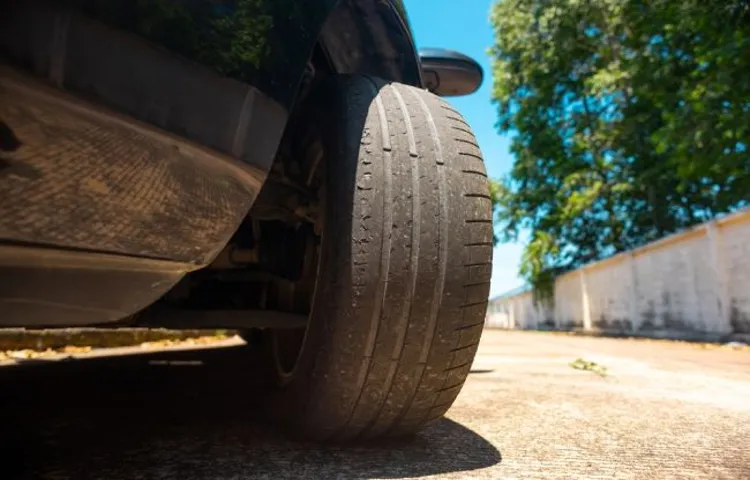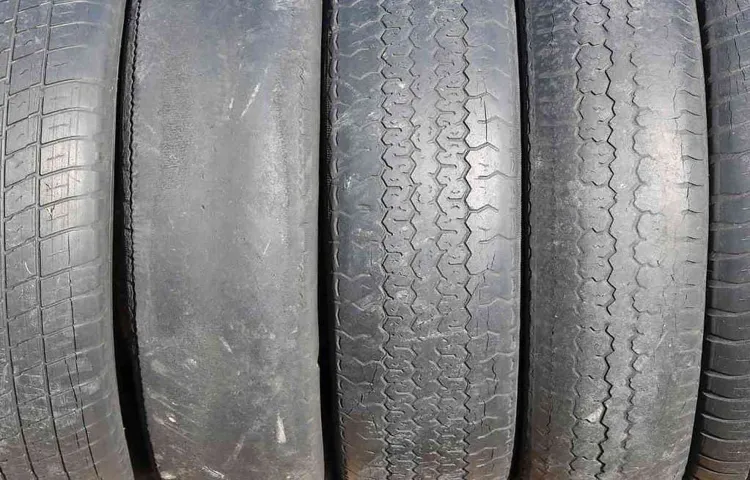Driving on bald tires is not only risky, but it can also put you in great danger. Tires are the most important component of your vehicle as they directly connect your car to the road. Bald tires are worn-out tires that have no traction left on them, leaving them smooth and unable to grip the road.
In fact, experts suggest that driving on bald tires is almost as bad as driving on a sheet of ice. How long can you drive on a bald tire before it becomes a problem? The answer to this question is not fixed, as it depends on various factors that we will explore in this blog post. By the end of this post, you’ll be able to evaluate the condition of your tires and know when it’s time to replace them.
Table of Contents
Tire Tread Depth
How long can you drive on a bald tire? It’s important to check the tread depth of your tires regularly to avoid reaching this point. Tread depth is crucial because it affects the tire’s ability to grip the road and disperse water in wet conditions. Over time, the tread on your tires will wear down.
If it’s not checked and replaced in time, you risk driving on a bald tire. Driving on a bald tire can be dangerous, as it greatly reduces the tire’s effectiveness and increases the chance of a blowout. As a general rule, it’s recommended to replace tires when the tread depth reaches 2/32 of an inch.
This is the legal minimum threshold in most states, and anything below this is considered bald and unsafe to drive on. Don’t risk your safety by driving on bald tires. Stay on top of your tire maintenance and replace them when they’re worn down to ensure a smooth and safe ride.
What is considered a bald tire?
When it comes to tire safety, tread depth is a crucial factor to consider. A bald tire is typically defined as a tire with under 2/32” of remaining tread depth. Tread depth is important for several reasons, including providing proper traction and handling on wet or slippery road surfaces.
Proper tread depth allows the tire to effectively grip the road, while inadequate tread depth can lead to skidding and hydroplaning. It’s important to regularly check your tire’s tread depth, especially if you frequently drive in wet conditions. If your tires are bald, it’s time to replace them immediately.
Don’t risk your safety by driving on bald tires. Instead, invest in new tires to ensure you have the best possible traction and handling on the road.

How to measure tire tread depth?
Tire tread depth is an essential factor for road safety, and it’s crucial to measure it regularly. The easiest way to check tire tread depth is to use a tire gauge or penny. First, locate the tire’s tread wear indicator bar, which is a small rubber bar that spans across the tire’s grooves.
If the wear bar is visible, it means your tire has worn out, and it’s time to replace it. If the wear bars aren’t visible, you can use a tire gauge to measure the tire’s depth. Place the gauge into the grooves and measure the distance between the gauge’s base and the top of the tread blocks.
A minimum tread depth of 2/32 inch is recommended. You can also use a penny to measure tire tread depth. Insert the penny into the tire groove, head-side facing down, and if you can see the top of Lincoln’s head, it’s time to replace the tire.
Checking tire tread depth is vital to ensure your car’s safety on the road, providing better traction and grip on wet and slippery surfaces.
Risks of Driving on Bald Tires
Driving on bald tires can be extremely risky. Bald tires have little to no tread left on them, which means there’s less grip on the road. This can make it harder to steer, brake, and accelerate, especially in wet or slippery conditions.
In fact, some studies suggest that bald tires can increase stopping distance by up to 18% on wet roads. Additionally, bald tires are more prone to punctures and blowouts, which can be dangerous and cause you to lose control of your vehicle. So, how long can you drive on a bald tire? The answer is: you shouldn’t be driving on bald tires at all.
It’s important to regularly check your tires for wear and tear, and replace them when the tread gets too low. Investing in new tires may seem expensive, but it’s a small price to pay for your safety and the safety of those around you on the road.
Decreased Traction
Driving on bald tires can pose serious risks to you and your vehicle. One major risk is decreased traction. Bald tires have little to no tread, which means they can’t grip the road as effectively as tires with more tread.
This can make it much harder to maintain control of your vehicle, especially in wet or icy conditions. It can also increase your stopping distance, making it more difficult to avoid accidents. Think of it like trying to walk on an icy sidewalk in shoes with no grip – you’re much more likely to slip and fall.
The same goes for driving on bald tires – you’re more likely to lose control and end up in an accident. So if you notice that your tires are starting to look bald, it’s important to get them replaced as soon as possible to avoid these risks on the road.
Hydroplaning
Hydroplaning is a scary experience that can happen to any driver, especially if their car has bald tires. This occurs when there’s a buildup of water between the tires and the road, causing the vehicle to lose contact with the road surface and skid out of control. Bald tires are prone to hydroplaning because they don’t have enough tread depth to displace water.
In fact, the risk of hydroplaning increases significantly if the tires are worn out, so it’s essential to keep them in good condition. Driving on bald tires is hazardous, particularly in wet weather, as it increases the likelihood of losing control of the vehicle. So, if you notice that your tires are bald, it’s best to replace them immediately before you encounter a potentially dangerous situation.
Don’t compromise your safety; invest in quality tires with ample tread depth. Remember, even a small amount of water on the road can be a danger, so always be cautious when driving in the rain.
Increased Stopping Distance
Driving on bald tires can be a very risky move that many drivers unwittingly make. One of the biggest risks associated with bald tires is increased stopping distance. When your tires are worn down, they lose their treads, which means they can’t grip the road as well.
This leads to longer stopping distances and difficulty in maintaining control, especially in poor weather conditions like rain or snow. When you brake, the tread’s job is to grip the road and create enough friction to bring the vehicle to a stop. Without proper tire traction, this process takes longer, which can be dangerous, particularly in emergency situations.
It’s always a good idea to keep your tires well-maintained and replace them when they become too worn to ensure that you’re driving safely on the road. By replacing bald tires with new ones, you can help maintain control over your vehicle in all road conditions. Remember, a safe driver is a responsible driver.
Laws and Regulations
Having bald tires on your vehicle can be dangerous and may cause accidents. So, if you’re wondering how long you can drive on bald tires, the answer is simple: you shouldn’t drive on them at all. In fact, driving on bald tires is illegal and can result in hefty fines or even imprisonment.
The tread on your tires is crucial in maintaining your vehicle’s grip on the road, especially when driving on wet or slippery surfaces. A tire with little or no tread can easily lose traction and lead to skids, hydroplaning, and other dangerous situations. Moreover, it can significantly compromise your stopping distance, making it harder to brake in emergencies.
Therefore, it’s essential to replace your tires as soon as they start to wear out or lose tread depth. It’s recommended that you have at least 2/32 inch of tread depth left on your tires, as this is the minimum legal requirement in most states and a safe threshold for optimal performance. Remember, investing in new tires is a small price to pay for your safety and the safety of others on the road.
State and Federal Laws
Laws and Regulations When it comes to legal matters, it’s important to understand the difference between state and federal laws. State laws vary from one state to another and can cover a wide range of topics, including family law, criminal law, and business law. In contrast, federal laws are laws that apply to the entire country and can cover topics such as civil rights, taxation, and environmental protection.
While state and federal laws have some overlap, federal law tends to take precedence over state law in matters concerning interstate commerce or federal government jurisdiction. It’s important to understand the laws and regulations that apply to your specific situation to ensure compliance and avoid legal issues. Seeking the advice of a qualified attorney can help you navigate the complex legal system with confidence.
Insurance Policies
When it comes to insurance policies, there are laws and regulations that govern how they are created and sold. These laws vary from state to state, but they are designed to protect consumers from unscrupulous insurance companies and agents. For example, insurance companies are required to provide clear and concise information about their policies, including any limitations or exclusions.
They are also required to provide a grace period for policyholders who miss a payment, so they do not lose their coverage immediately. Furthermore, insurance companies and agents are not allowed to discriminate against applicants based on certain factors, such as race or gender. These laws and regulations ensure that insurance policies are fair and transparent, and that consumers can make informed decisions about the coverage that they need.
As a consumer, it’s important to understand your rights under these laws and regulations and to do your research before purchasing an insurance policy.
Final Thoughts
If you’re wondering how long you can drive on a bald tire, the answer is “not very long.” Bald tires can be extremely dangerous and increase your risk of losing control of your vehicle, especially in wet or slippery conditions. Your stopping distance will be significantly longer, and you’ll have less grip on the road.
Additionally, driving on bald tires can cause damage to your rims and suspension, which can be costly to repair. It’s important to regularly check the tread depth on your tires and replace them when they become worn. Don’t risk your safety or the safety of others on the road – invest in new tires as soon as you notice signs of wear.
Conclusion
In conclusion, driving on a bald tire is like trying to run a marathon with worn-out shoes. You might be able to make it a few miles, but eventually, the lack of traction and stability will catch up to you. So don’t risk your safety or the safety of others on the road.
Replace those bald tires and hit the road with confidence!”
FAQs
What is a bald tire and why is it dangerous to drive with one?
A bald tire is a tire with little to no tread remaining. It is dangerous to drive with a bald tire because it can cause the vehicle to lose traction on wet or slippery roads, leading to an increased risk of accidents.
How can I tell if my tire is bald?
You can check the tread depth of your tires using a tread depth gauge or a penny. If the tread depth is less than 2/32 of an inch (or if you can see the top of Lincoln’s head on the penny), it’s time to replace your tire.
Is it legal to drive with bald tires?
No, it is not legal to drive with bald tires as it can pose a safety risk to yourself and other drivers on the road. Depending on the state, you may face fines or other penalties for driving with bald tires.
How long can I drive with a bald tire before I have to replace it?
It is recommended to replace bald tires as soon as possible. Driving on a bald tire can be dangerous and increase the risk of accidents, so it’s best to get it replaced as soon as you notice the tread is worn down.
Can I still drive in dry conditions with a bald tire?
While you may still be able to drive with a bald tire in dry conditions, it is not recommended. A tire with little to no tread may not be able to grip the road properly, which can cause the vehicle to lose control and result in an accident.
How can I prevent my tires from becoming bald?
To prevent your tires from becoming bald, you should regularly check the tread depth and rotate your tires every 5,000 to 7,500 miles. Additionally, try to avoid driving on rough or poorly maintained roads, and avoid sudden stops or starts.
What is the cost of replacing a bald tire?
The cost of replacing a bald tire can vary depending on the tire brand and size. On average, it can cost anywhere from $50 to $200 per tire. However, the cost of replacing a tire is small compared to the potential costs of an accident caused by driving on a bald tire.



